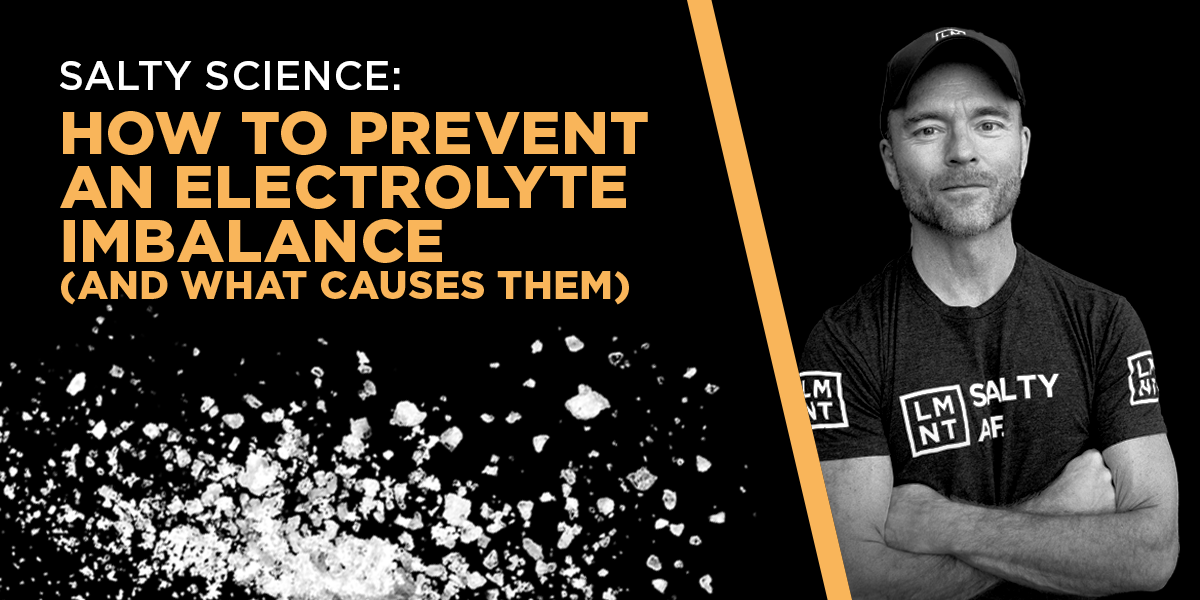An electrolyte imbalance is an underrecognized cause of both mild and more serious health problems—including headaches, muscle cramps, low energy, fatigue, dizziness, confusion, bone density issues, weakness, seizures, and even brain damage.
But many of these symptoms are present among other conditions too. As a result, people look elsewhere—like to dehydration, for example—when looking for a root cause.
Yet dehydration (losing more water than you take in) isn’t the life-sucking, ever-present condition it’s made out to be. Athletes, it’s been shown, perform perfectly fine in a dehydrated state. And even when water losses exceed 5% of body weight, athletes generally don’t suffer more muscle cramps.
Nonetheless, most hydration advice centers around preventing dehydration. This singular focus, unfortunately, increases the risk of electrolyte disturbances, which may prove to be the more dangerous problem.
Why? Because when you drink water without replacing electrolytes, you alter the concentration of electrolytes in your blood, especially the concentration of sodium. Drinking too much water dilutes serum sodium.
And less sodium in the blood means more symptoms like the ones I mentioned earlier. It’s why you see marathon runners stumbling around, dazed and confused at the finish line. They’ve had too much water. They’re critically low on sodium.
Of course, drinking too much water isn’t the only cause of electrolyte imbalances. I want to cover the spectrum of potential causes today, along with simple tips for maintaining healthy electrolyte levels.
But first, let’s talk about why we need electrolytes.
Why Electrolytes Matter
Electrolytes are aptly named. These charged minerals conduct electricity in your body, allowing cells and nerves to communicate with one another.
Electrolytes are also essential for maintaining the balance of fluids in your body. Most of your body is made up of water, and this water is distributed inside and outside your cells. Electrolytes regulate this fluid partitioning.
Proper fluid balance is the sine qua non of healthy hydration. It’s essential if you want to keep your blood flowing in your vessels, your brain floating in your skull, and your muscles primed to contract or relax when needed. Personally, I enjoy all of the above.
The main electrolytes that regulate fluid balance are sodium and potassium. Sodium regulates fluids outside the cell and potassium regulates fluid inside the cell.
Disturbances in either electrolyte will disrupt fluid balance. For instance:
- Too much sodium will temporarily increase blood volume and blood pressure
- Too little sodium can cause brain swelling
- Inadequate potassium can lead to higher blood pressure
Fortunately, your body does a wonderful job of balancing fluid and electrolyte levels. Your brain, for instance, is always monitoring two key hydration markers:
- Blood volume
- Blood osmolality
If blood volume is low, receptors in your brain understand that you need more water. Then your hypothalamus stimulates thirst and you have a drink. Problem solved.
What about blood osmolality? Osmolality is the concentration of electrolytes (especially sodium) in your blood. As osmolality rises, thirst goes up. That’s why salty foods make you thirsty. Drinking water helps bring osmolality back down into healthy ranges.
Your kidneys also work around the clock to keep fluids and electrolytes within healthy ranges. If you’ve ever swilled too much water (or spent too much time at dollar beer night), you’ve seen this firsthand as you hustle to the bathroom.
Peeing out fluids is a protective measure. It not only removes the excess fluid but also restores serum sodium levels.
I could talk all day about your body’s impressive fluid balancing system. But in this blog, we’re more concerned with how things go wrong.
Electrolyte Imbalances: Causes and Symptoms
An electrolyte imbalance is when the concentration of a given electrolyte in your blood becomes too low or too high. This imbalance can bring with it a range of unpleasant symptoms.
The general drivers of electrolyte imbalance include:
- Excess water intake (especially in the context of heavy sweat loss)
- A medical condition such as heart or kidney failure
- Certain medications
- Vomiting and diarrhea
- Inadequate electrolyte consumption
- Alcohol consumption and its hormonal consequences
Let’s talk about specific electrolytes now. The full list includes sodium, chloride, potassium, magnesium, calcium, phosphate, and bicarbonate. Today, however, I’m just going to cover sodium, potassium, magnesium, and calcium imbalances. They’re the most common.
Sodium Imbalance
Low serum sodium is called hyponatremia. The symptoms of hyponatremia include confusion, headaches, cramps, fatigue, weakness, and in severe cases: seizures, brain damage, and death.
Heart failure, kidney failure, liver disease, cancer, diuretics, vomiting, and diarrhea can all cause hyponatremia, as can consuming too much sodium-free water. Overhydration largely explains why a large proportion of endurance athletes (~15%) develop exercise-associated hyponatremia.
Since many of the symptoms overlap, hyponatremia is often confused with dehydration. But treating hyponatremia with more water only exacerbates the condition. In some tragic instances, this common point of confusion has proven fatal.
Sodium levels can also fall from excessive sweating in the heat. If that sodium isn’t replaced, a sodium imbalance can occur.
High serum sodium, or hypernatremia, is less common than hyponatremia—and it’s rarely due to excess salt intake. Rather, it results from dehydration due to a variety of medical conditions or a broken thirst mechanism. The symptoms are similar to those of low sodium.
Potassium Imbalance
The medical term for low serum potassium is hypokalemia. The symptoms include slower heart rate, cardiac arrhythmias, muscle cramps, and in severe cases life-threatening heart complications.
Kidney failure, heart failure, and any illness that induces diarrhea or vomiting can cause hypokalemia. Keep in mind that potassium is lost directly through stool and vomit.
Is hypokalemia caused by low potassium intake? Not by itself. But inadequate potassium intake has other consequences.
When you’re deficient in potassium—even moderately deficient—it increases the ratio of sodium to potassium, which then elevates blood pressure. Higher potassium intakes, on the other hand, are correlated with lower blood pressure, and therefore lower heart disease risk.
To be clear, a high intake of dietary potassium intakes is not dangerous. High serum potassium (hyperkalemia) is usually due to a medical condition.
Magnesium Imbalance
Magnesium doesn’t govern fluid balance, but it has plenty of other jobs. It helps build bone, regulate muscle function, and produce the cellular energy currency known as ATP.
Magnesium deficiency is usually caused by inadequate intake of magnesium-rich foods. The signs and symptoms include muscle cramps, fatigue, low blood calcium levels, low blood potassium levels, and high blood pressure.
Too much supplemental magnesium can have a laxative effect, but shouldn’t be dangerous in those with healthy kidneys. Those with kidney disease, however, should be mindful of hypermagnesemia (high serum magnesium) when supplementing.
Calcium Imbalance
The most common consequences of calcium deficiency (hypocalcemia) include:
- Osteoporosis: A disorder of decreased bone density and increased fracture risk.
- Tetany: A condition of tremors, spasms, and sometimes seizures.
- Rickets: A childhood disorder of skeletal deformities, weakness, and brittle bones.
Calcium status is closely linked to vitamin D status. If you’re low on vitamin D, you’ll have trouble absorbing calcium. Conversely, too much vitamin D can provoke a high-calcium state called hypercalcemia.
The main concern with hypercalcemia is soft tissue calcification. This calcification can occur in the kidneys (as kidney stones), the heart, the breast, and many other places. Some research suggests that calcium supplements cause a temporary state of hypercalcemia that may increase heart disease risk. That’s why I suggest getting your daily gram of calcium from dietary sources.
How To Prevent Electrolyte Imbalances
How you treat or prevent an electrolyte imbalance will differ depending on what’s causing it. If excess water consumption is causing a sodium imbalance, the solution (obviously) involves drinking less water.
Things get more complicated when dealing with a medical condition. See your doctor in these situations. Most clinicians understand the vital importance of managing electrolytes.
Medical conditions aside, there are two main strategies for warding off electrolyte disturbances in daily life:
- Consume electrolyte-rich foods
- Drink electrolyte water to thirst
I’ll expand on these strategies now.
#1: Consume electrolyte-rich foods
Consuming electrolyte-rich foods means tweaking your diet to get enough sodium, magnesium, potassium, and calcium. Here are the daily targets I recommend based on published literature:[*][*][*][*]
- 4–6 grams sodium. Get it by salting your food aggressively. (4–6 grams sodium is 2–3 teaspoons of salt).
- 3.5–5 grams potassium. Look to green leafy vegetables, fruits, sweet potatoes, avocados, and meat.
- 400–600 mg magnesium. Look to green leafies and nuts.
- 1 gram calcium. Look to dairy, bones, and cruciferous vegetables.
Any shortfalls can be plugged with supplementation. The exception is calcium, which I’m not super comfortable supplementing.
#2: Drink electrolyte water to thirst
“Drink electrolyte water to thirst” is my golden rule of hydration. The drinking to thirst part ensures you don’t over-hydrate and dilute blood sodium levels. And the electrolyte part ensures you replace electrolytes lost through sweat, urine, and feces.
Sweat loss is the big one for active folks. If you don’t replace that lost sodium, you’re bound to feel like a horse’s rear. (Believe me, I know!).
Sports drinks and scammy “electrolyte-infused” waters won’t do the trick. They have too much sugar, too few electrolytes, or some combination of these shortfalls.
For true electrolyte water, combine salt, lemon, and H2O—or mix a stick of Drink LMNT into your water bottle. (I’m partial to Orange Salt). Drink to thirst, enjoy, and bid your electrolyte issues farewell.

